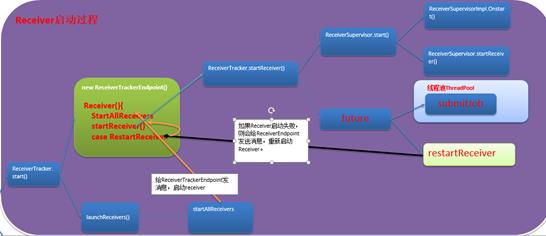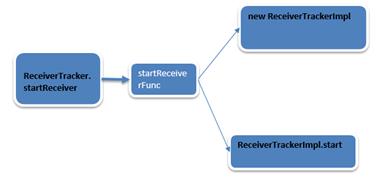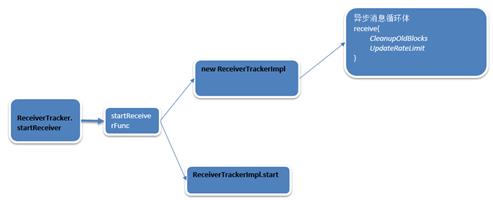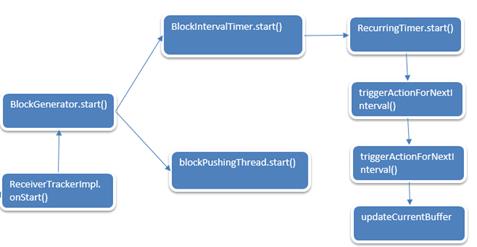Spark Streaming源码解读之流数据不断接收详解
Posted snail_gesture
tags:
篇首语:本文由小常识网(cha138.com)小编为大家整理,主要介绍了Spark Streaming源码解读之流数据不断接收详解相关的知识,希望对你有一定的参考价值。
特别说明:
在上一遍文章中有详细的叙述Receiver启动的过程,如果不清楚的朋友,请您查看上一篇博客,这里我们就基于上篇的结论,继续往下说。
博文的目标是:
Spark Streaming在接收数据的全生命周期贯通
组织思路如下:
a) 接收数据的架构模式的设计
b) 然后再具体源码分析
接收数据的架构模式的设计
1. 当有Spark Streaming有application的时候Spark Streaming会持续不断的接收数据。
2. 一般Receiver和Driver不在一个进程中的,所以接收到数据之后要不断的汇报给Driver。
3. Spark Streaming要接收数据肯定要使用消息循环器,循环器不断的接收到数据之后,然后将数据存储起来,再将存储完的数据汇报给Driver。
4. Spark Streaming数据接收的过程也是MVC的架构,M是model也就是Receiver.
C是Control也就是存储级别的ReceiverSupervisor。V是界面。
5. ReceiverSupervisor是控制器,Receiver的启动是靠ReceiverTracker启动的,Receiver接收到数据之后是靠ReceiverSupervisor存储数据的。然后Driver就获得元数据也就是界面,通过界面来操作底层的数据,这个元数据就相当于指针。
Spark Streaming接收数据流程如下:

具体源码分析
1. ReceiverTracker通过发送Job的方式,并且每个Job只有一个Task,并且Task中只通过一个ReceiverSupervisor启动一个Receiver.
2. 下图就是Receiver启动的流程图,现在就从ReceiverTracker的start开始今天的旅程。

3. Start方法中创建Endpoint实例
/** Start the endpoint and receiver execution thread. */
def start(): Unit = synchronized
if (isTrackerStarted)
throw new SparkException("ReceiverTracker already started")
if (!receiverInputStreams.isEmpty)
endpoint = ssc.env.rpcEnv.setupEndpoint(
"ReceiverTracker", new ReceiverTrackerEndpoint(ssc.env.rpcEnv))
if (!skipReceiverLaunch) launchReceivers()
logInfo("ReceiverTracker started")
trackerState = Started
4. LaunchReceivers源码如下:
/**
* Get the receivers from the ReceiverInputDStreams, distributes them to the
* worker nodes as a parallel collection, and runs them.
*/
private def launchReceivers(): Unit =
val receivers = receiverInputStreams.map(nis =>
val rcvr = nis.getReceiver()
rcvr.setReceiverId(nis.id)
rcvr
)
runDummySparkJob()
logInfo("Starting " + receivers.length + " receivers")
//此时的endpoint就是前面实例化的ReceiverTrackerEndpoint
endpoint.send(StartAllReceivers(receivers))
5. 从图上可以知道,send发送消息之后,ReceiverTrackerEndpoint的receive就接收到了消息。
override def receive: PartialFunction[Any, Unit] =
// Local messages
case StartAllReceivers(receivers) =>
val scheduledLocations = schedulingPolicy.scheduleReceivers(receivers, getExecutors)
for (receiver <- receivers)
val executors = scheduledLocations(receiver.streamId)
updateReceiverScheduledExecutors(receiver.streamId, executors)
receiverPreferredLocations(receiver.streamId) = receiver.preferredLocation
startReceiver(receiver, executors)
6. startReceiver源码如下:
/**
* Start a receiver along with its scheduled executors
*/
private def startReceiver(
receiver: Receiver[_],
scheduledLocations: Seq[TaskLocation]): Unit =
def shouldStartReceiver: Boolean =
// It's okay to start when trackerState is Initialized or Started
!(isTrackerStopping || isTrackerStopped)
val receiverId = receiver.streamId
if (!shouldStartReceiver)
onReceiverJobFinish(receiverId)
return
val checkpointDirOption = Option(ssc.checkpointDir)
val serializableHadoopConf =
new SerializableConfiguration(ssc.sparkContext.hadoopConfiguration)
// startReceiverFunc就是我们通过RDD启动Job的那个Func
// Function to start the receiver on the worker node
//此时虽然是iterator但是就是一个Receiver,因为你如果追溯一下前面StartReceiver被调用的时候是for循环遍历Receivers.
val startReceiverFunc: Iterator[Receiver[_]] => Unit =
(iterator: Iterator[Receiver[_]]) =>
if (!iterator.hasNext)
throw new SparkException(
"Could not start receiver as object not found.")
if (TaskContext.get().attemptNumber() == 0)
val receiver = iterator.next()
assert(iterator.hasNext == false)
//此时的receiver是根据数据输入来源创建的InputDStream
//例如socketInputDStream他有自己的receiver也就是SocketReceiver
//此时receiver就相当于一个引用句柄。他只是引用的描述
val supervisor = new ReceiverSupervisorImpl(
receiver, SparkEnv.get, serializableHadoopConf.value, checkpointDirOption)
//当startReceiverFunc被调用的时候ReceiverSupervisorImpl的start方法就会运行。
supervisor.start()
supervisor.awaitTermination()
else
// It's restarted by TaskScheduler, but we want to reschedule it again. So exit it.
// Create the RDD using the scheduledLocations to run the receiver in a Spark job
val receiverRDD: RDD[Receiver[_]] =
if (scheduledLocations.isEmpty)
//此时Seq(receiver)中只有一个Receiver
ssc.sc.makeRDD(Seq(receiver), 1)
else
val preferredLocations = scheduledLocations.map(_.toString).distinct
ssc.sc.makeRDD(Seq(receiver -> preferredLocations))
//专门为了创建receiver而创建的RDD
receiverRDD.setName(s"Receiver $receiverId")
ssc.sparkContext.setJobDescription(s"Streaming job running receiver $receiverId")
ssc.sparkContext.setCallSite(Option(ssc.getStartSite()).getOrElse(Utils.getCallSite()))
val future = ssc.sparkContext.submitJob[Receiver[_], Unit, Unit](
receiverRDD, startReceiverFunc, Seq(0), (_, _) => Unit, ())
// We will keep restarting the receiver job until ReceiverTracker is stopped
future.onComplete
case Success(_) =>
if (!shouldStartReceiver)
onReceiverJobFinish(receiverId)
else
logInfo(s"Restarting Receiver $receiverId")
self.send(RestartReceiver(receiver))
case Failure(e) =>
if (!shouldStartReceiver)
onReceiverJobFinish(receiverId)
else
logError("Receiver has been stopped. Try to restart it.", e)
logInfo(s"Restarting Receiver $receiverId")
self.send(RestartReceiver(receiver))
(submitJobThreadPool)
logInfo(s"Receiver $receiver.streamId started")
6. startReceiver源码如下:
/**
* Start a receiver along with its scheduled executors
*/
private def startReceiver(
receiver: Receiver[_],
scheduledLocations: Seq[TaskLocation]): Unit =
def shouldStartReceiver: Boolean =
// It's okay to start when trackerState is Initialized or Started
!(isTrackerStopping || isTrackerStopped)
val receiverId = receiver.streamId
if (!shouldStartReceiver)
onReceiverJobFinish(receiverId)
return
val checkpointDirOption = Option(ssc.checkpointDir)
val serializableHadoopConf =
new SerializableConfiguration(ssc.sparkContext.hadoopConfiguration)
// startReceiverFunc就是我们通过RDD启动Job的那个Func
// Function to start the receiver on the worker node
//此时虽然是iterator但是就是一个Receiver,因为你如果追溯一下前面StartReceiver被调用的时候是for循环遍历Receivers.
val startReceiverFunc: Iterator[Receiver[_]] => Unit =
(iterator: Iterator[Receiver[_]]) =>
if (!iterator.hasNext)
throw new SparkException(
"Could not start receiver as object not found.")
if (TaskContext.get().attemptNumber() == 0)
val receiver = iterator.next()
assert(iterator.hasNext == false)
//此时的receiver是根据数据输入来源创建的InputDStream
//例如socketInputDStream他有自己的receiver也就是SocketReceiver
//此时receiver就相当于一个引用句柄。他只是引用的描述
val supervisor = new ReceiverSupervisorImpl(
receiver, SparkEnv.get, serializableHadoopConf.value, checkpointDirOption)
//当startReceiverFunc被调用的时候ReceiverSupervisorImpl的start方法就会运行。
supervisor.start()
supervisor.awaitTermination()
else
// It's restarted by TaskScheduler, but we want to reschedule it again. So exit it.
// Create the RDD using the scheduledLocations to run the receiver in a Spark job
val receiverRDD: RDD[Receiver[_]] =
if (scheduledLocations.isEmpty)
//此时Seq(receiver)中只有一个Receiver
ssc.sc.makeRDD(Seq(receiver), 1)
else
val preferredLocations = scheduledLocations.map(_.toString).distinct
ssc.sc.makeRDD(Seq(receiver -> preferredLocations))
//专门为了创建receiver而创建的RDD
receiverRDD.setName(s"Receiver $receiverId")
ssc.sparkContext.setJobDescription(s"Streaming job running receiver $receiverId")
ssc.sparkContext.setCallSite(Option(ssc.getStartSite()).getOrElse(Utils.getCallSite()))
val future = ssc.sparkContext.submitJob[Receiver[_], Unit, Unit](
receiverRDD, startReceiverFunc, Seq(0), (_, _) => Unit, ())
// We will keep restarting the receiver job until ReceiverTracker is stopped
future.onComplete
case Success(_) =>
if (!shouldStartReceiver)
onReceiverJobFinish(receiverId)
else
logInfo(s"Restarting Receiver $receiverId")
self.send(RestartReceiver(receiver))
case Failure(e) =>
if (!shouldStartReceiver)
onReceiverJobFinish(receiverId)
else
logError("Receiver has been stopped. Try to restart it.", e)
logInfo(s"Restarting Receiver $receiverId")
self.send(RestartReceiver(receiver))
(submitJobThreadPool)
logInfo(s"Receiver $receiver.streamId started")
7. 现在就追踪一下receiver参数的传递过程。先找到startReceiver在哪里调用。
override def receive: PartialFunction[Any, Unit] =
// Local messages
case StartAllReceivers(receivers) =>
val scheduledLocations = schedulingPolicy.scheduleReceivers(receivers, getExecutors)
for (receiver <- receivers)
val executors = scheduledLocations(receiver.streamId)
updateReceiverScheduledExecutors(receiver.streamId, executors)
receiverPreferredLocations(receiver.streamId) = receiver.preferredLocation
startReceiver(receiver, executors)
8. 可以看出receiver是StartAllReceivers方法传入的,继续追踪StartAllReceivers。
通过getReceiver就获得了receiver的对象。
/**
* Get the receivers from the ReceiverInputDStreams, distributes them to the
* worker nodes as a parallel collection, and runs them.
*/
private def launchReceivers(): Unit =
val receivers = receiverInputStreams.map(nis =>
val rcvr = nis.getReceiver()
rcvr.setReceiverId(nis.id)
rcvr
)
runDummySparkJob()
logInfo("Starting " + receivers.length + " receivers")
endpoint.send(StartAllReceivers(receivers))
submitJob的时候就提交了作业,在具体的节点上运行Job,此时是通过ReceiverSupervisorImpl完成的。
此时在ReceiverTracker的startReceiver调用的时候完成了两件事:

ReceiverTrackerImpl的初始化和start方法的调用。
第一步:ReceiverTrackerImpl的初始化
1. ReceiverSupervisor负责接收receiver接收的数据,之后,ReceiverSupervisor会存储数据,然后汇报给Driver。Receiver是一条一条的接收数据(Kafka是 Key Value的形式)。
/**
* Concrete implementation of [[org.apache.spark.streaming.receiver.ReceiverSupervisor]]
* which provides all the necessary functionality for handling the data received by
* the receiver. Specifically, it creates a [[org.apache.spark.streaming.receiver.BlockGenerator]]
* object that is used to divide the received data stream into blocks of data.
*/
private[streaming] class ReceiverSupervisorImpl(
2. ReceiverSupervisorImpl初始化源码如下:
/** Remote RpcEndpointRef for the ReceiverTracker */
//负责链接ReceiverTracker的消息通信体
private val trackerEndpoint = RpcUtils.makeDriverRef("ReceiverTracker", env.conf, env.rpcEnv)
/** RpcEndpointRef for receiving messages from the ReceiverTracker in the driver */
//endpoint负责在Driver端接收ReceiverTracker发送来的消息。
private val endpoint = env.rpcEnv.setupEndpoint(
"Receiver-" + streamId + "-" + System.currentTimeMillis(), new ThreadSafeRpcEndpoint
override val rpcEnv: RpcEnv = env.rpcEnv
override def receive: PartialFunction[Any, Unit] =
case StopReceiver =>
logInfo("Received stop signal")
ReceiverSupervisorImpl.this.stop("Stopped by driver", None)
//每个Batch处理完数据之后,Driver的ReceiverTracker会发消息给ReceiverTrackerImpl要求清理Block信息。
case CleanupOldBlocks(threshTime) =>
logDebug("Received delete old batch signal")
cleanupOldBlocks(threshTime)
//限制receiver接收数据的,也就是限流的。这样的话就可以动态的改变receiver
//的数据接收速度。
case UpdateRateLimit(eps) =>
logInfo(s"Received a new rate limit: $eps.")
registeredBlockGenerators.foreach bg =>
bg.updateRate(eps)
)
cleanupOldBlocks源码如下:
private def cleanupOldBlocks(cleanupThreshTime: Time): Unit =
logDebug(s"Cleaning up blocks older then $cleanupThreshTime")
receivedBlockHandler.cleanupOldBlocks(cleanupThreshTime.milliseconds)
3. 从对象中获得限流的速度,这对于实际生产环境非常重要,因为有时间数据请求量非常的多,整个集群又处理不完或者来不及处理,这个时候如果不限流的话,延迟就非常的高。
/**
* Set the rate limit to `newRate`. The new rate will not exceed the maximum rate configured by
* spark.streaming.receiver.maxRate, even if `newRate` is higher than that.
*
* @param newRate A new rate in events per second. It has no effect if it's 0 or negative.
*/
private[receiver] def updateRate(newRate: Long): Unit =
if (newRate > 0)
if (maxRateLimit > 0)
rateLimiter.setRate(newRate.min(maxRateLimit))
else
rateLimiter.setRate(newRate)
至此上面就完成了ReceiverSupervisorImpl的初始化。这里只是简单的提了一些,后面还会详解

第二步:ReceiverTrackerImpl的start方法被调用。
在ReceiverTrackerImpl的函数中,并没有start方法,这个时候的实现是在其父类start方法中实现的。
4. 在supervisor启动的时候会调用ReceiverSupervisor的start方法
/** Start the supervisor */
def start()
onStart()
startReceiver()
5. onstart方法: 此方法必须在receiver.onStart()之前被调用,来确保BlockGenerator被实例化和启动。Receiver在接收数据的时候是通过BlockGenerator转换成Block形式,因为Receiver一条一条的接收数据,需要将此数据合并成Block,RDD的处理单位是Block。
/**
* Called when supervisor is started.
* Note that this must be called before the receiver.onStart() is called to ensure
* things like [[BlockGenerator]]s are started before the receiver starts sending data.
*/
protected def onStart()
6. onStart方法具体实现是在RceiverSupervisorImpl方法中实现的。
override protected def onStart()
registeredBlockGenerators.foreach _.start()
什么是BlockGenerator?
将接收到的数据以Batch的方式存在,并且以特定的频率存储。
BlockGenerator会启动两条线程:
1. 一条线程会周期性的把Receiver接收到的数据合并成Block。
2. 另一条线程是把接收到的数据使用BlockManager存储。
BlockGenerator继承自RateLimiter,由此可以看出无法限定流熟度,但是可以限定存储的速度,转过来限制流进来的速度。
/**
* Generates batches of objects received by a
* [[org.apache.spark.streaming.receiver.Receiver]] and puts them into appropriately
* named blocks at regular intervals. This class starts two threads,
* one to periodically start a new batch and prepare the previous batch of as a block,
* the other to push the blocks into the block manager.
*
* Note: Do not create BlockGenerator instances directly inside receivers. Use
* `ReceiverSupervisor.createBlockGenerator` to create a BlockGenerator and use it.
*/
private[streaming] class BlockGenerator(
listener: BlockGeneratorListener,
receiverId: Int,
conf: SparkConf,
clock: Clock = new SystemClock()
) extends RateLimiter(conf) with Logging
BlockGenerator是怎么产生的?
7. 在ReceiverSupervisorImpl的createBlockGenerator方法中实现了BlockGenerator的创建。
override def createBlockGenerator(
blockGeneratorListener: BlockGeneratorListener): BlockGenerator =
// Cleanup BlockGenerators that have already been stopped
registeredBlockGenerators --= registeredBlockGenerators.filter _.isStopped()
//一个streamId指服务于一个BlockGenerator
val newBlockGenerator = new BlockGenerator(blockGeneratorListener, streamId, env.conf)
registeredBlockGenerators += newBlockGenerator
newBlockGenerator
8. 回到上面ReceiverTrackerImpl的onStart方法
override protected def onStart()
//启动BlockGenerator的定时器不断的把数据放在内存中的Buffer中然后将多条Buffer合并成Block,此时只是准备去接收Receiver的数据
registeredBlockGenerators.foreach _.start()
9. BlockGenerator的start方法启动了BlockGenerator的两条线程。
/** Start block generating and pushing threads. */
def start(): Unit = synchronized
if (state == Initialized)
state = Active
blockIntervalTimer.start()
blockPushingThread.start()
logInfo("Started BlockGenerator")
else
throw new SparkException(
s"Cannot start BlockGenerator as its not in the Initialized state [state = $state]")
- blockIntervalTimer是RecurringTimer实例。
private val blockIntervalTimer =
new RecurringTimer(clock, blockIntervalMs, updateCurrentBuffer, "BlockGenerator")
11. blockIntervalTimer的start方法。
/**
* Start at the earliest time it can start based on the period.
*/
def start(): Long =
start(getStartTime())
12. 启动线程
/**
* Start at the given start time.
*/
def start(startTime: Long): Long = synchronized
nextTime = startTime
thread.start()
logInfo("Started timer for " + name + " at time " + nextTime)
nextTime
13. Tread启动loop.
private val thread = new Thread("RecurringTimer - " + name)
setDaemon(true)
override def run() loop
14. Loop也就会调用triggerActionForNextInterval()
/**
* Repeatedly call the callback every interval.
*/
private def loop()
try
while (!stopped)
triggerActionForNextInterval()
triggerActionForNextInterval()
catch
case e: InterruptedException =>
15. 此时callback函数就会回调updateCurrentBuffer方法。
private def triggerActionForNextInterval(): Unit =
clock.waitTillTime(nextTime)
callback(nextTime)
prevTime = nextTime
nextTime += period
logDebug("Callback for " + name + " called at time " + prevTime)
16. 在RecurringTimer实例创建的时候,第三个参数传入的就是updateCurrentBuffer方法。
private[streaming]
class RecurringTimer(clock: Clock, period: Long, callback: (Long) => Unit, name: String)
extends Logging
17. 把接收到的数据放入到Buffer缓存中,然后再把Buffer按照一定的大小合并成Block.
/** Change the buffer to which single records are added to. */
private def updateCurrentBuffer(time: Long): Unit =
try
var newBlock: Block = null
synchronized
if (currentBuffer.nonEmpty)
val newBlockBuffer = currentBuffer
= new ArrayBuffer[Any]
val blockId = StreamBlockId(receiverId, time - blockIntervalMs)
listener.onGenerateBlock(blockId)
newBlock = new Block(blockId, newBlockBuffer)
if (newBlock != null)
//将生成成功的Block放入到队列中
blocksForPushing.put(newBlock) // put is blocking when queue is full
catch
case ie: InterruptedException =>
logInfo("Block updating timer thread was interrupted")
case e: Exception =>
reportError("Error in block updating thread", e)
BlockGenerator的start启动就分析完了,至此准备好接收Receiver数据了。
BlockGenerator的start启动过程如下:

至此ReceiverTrackerImpl的onStart就介绍完了。
18. 回到ReceiverSupervisor的start方法。
/** Start the supervisor */
def start()
onStart()
startReceiver()
19. 启动receiver
** Start receiver */
def startReceiver(): Unit = synchronized
try
if (onReceiverStart())
logInfo("Starting receiver")
receiverState = Started
receiver.onStart()
logInfo("Called receiver onStart")
else
// The driver refused us
stop("Registered unsuccessfully because Driver refused to start receiver " + streamId, None)
catch
case NonFatal(t) =>
stop("Error starting receiver " + streamId, Some(t))
onReceiverStart方法在ReceiverSupervisorImpl中实现的。
override protected def onReceiverStart(): Boolean =
val msg = RegisterReceiver(
//此时的endpoint是Receiver的管理者ReceiverSupervisorImpl的消息循环体
streamId, receiver.getClass.getSimpleName, host, executorId, endpoint)
//Driver端的Endpoint,此时的Boolean必须为true的时候才可以正在startReceiver等后续的工作。
//此时的消息就发送给了ReceiverTracker
trackerEndpoint.askWithRetry[Boolean](msg) //此时就将消息发送给Driver
Driver端:ReceiverTrackerEndpoint 接收到ReceiveSupervisor发来的消息。
20. 在receiverAndReply中接收的,源码如下:
override def receiveAndReply(context: RpcCallContext): PartialFunction[Any, Unit] =
// Remote messages
case RegisterReceiver(streamId, typ, host, executorId, receiverEndpoint) =>
val successful =
registerReceiver(streamId, typ, host, executorId, receiverEndpoint, context.senderAddress)
context.reply(successful)
case AddBlock(receivedBlockInfo) =>
if (WriteAheadLogUtils.isBatchingEnabled(ssc.conf, isDriver = true))
walBatchingThreadPool.execute(new Runnable
override def run(): Unit = Utils.tryLogNonFatalError
if (active)
context.reply(addBlock(receivedBlockInfo))
else
throw new IllegalStateException("ReceiverTracker RpcEndpoint shut down.")
)
else
context.reply(addBlock(receivedBlockInfo))
case DeregisterReceiver(streamId, message, error) =>
deregisterReceiver(streamId, message, error)
context.reply(true)
// Local messages
case AllReceiverIds =>
context.reply(receiverTrackingInfos.filter(_._2.state != ReceiverState.INACTIVE).keys.toSeq)
case StopAllReceivers =>
assert(isTrackerStopping || isTrackerStopped)
stopReceivers()
context.reply(true)
21. registerReceiver源码如下:
/** Register a receiver */
private def registerReceiver(
streamId: Int,
typ: String,
host: String,
executorId: String,
receiverEndpoint: RpcEndpointRef,
senderAddress: RpcAddress
): Boolean =
//判断streamId是否是元数据信息中的
if (!receiverInputStreamIds.contains(streamId))
throw new SparkException("Register received for unexpected id " + streamId)
if (isTrackerStopping || isTrackerStopped)
return false
val scheduledLocations = receiverTrackingInfos(streamId).scheduledLocations
val acceptableExecutors = if (scheduledLocations.nonEmpty)
// This receiver is registering and it's scheduled by
// ReceiverSchedulingPolicy.scheduleReceivers. So use "scheduledLocations" to check it.
scheduledLocations.get
else
// This receiver is scheduled by "ReceiverSchedulingPolicy.rescheduleReceiver", so calling
// "ReceiverSchedulingPolicy.rescheduleReceiver" again to check it.
scheduleReceiver(streamId)
def isAcceptable: Boolean = acceptableExecutors.exists
case loc: ExecutorCacheTaskLocation => loc.executorId == executorId
case loc: TaskLocation => loc.host == host
if (!isAcceptable)
// Refuse it since it's scheduled to a wrong executor
false
else
val name = s"$typ-$streamId"
val receiverTrackingInfo = ReceiverTrackingInfo(
streamId,
ReceiverState.ACTIVE,
scheduledLocations = None,
runningExecutor = Some(ExecutorCacheTaskLocation(host, executorId)),
name = Some(name),
endpoint = Some(receiverEndpoint))
receiverTrackingInfos.put(streamId, receiverTrackingInfo)
listenerBus.post(StreamingListenerReceiverStarted(receiverTrackingInfo.toReceiverInfo))
logInfo("Registered receiver for stream " + streamId + " from " + senderAddress)
true
22. 在Receiver的onstart方法必须初始化所有的资源内容,包括线程,buffer等来准备接收数据,并且必须是非阻塞的。
**
* This method is called by the system when the receiver is started. This function
* must initialize all resources (threads, buffers, etc.) necessary for receiving data.
* This function must be non-blocking, so receiving the data must occur on a different
* thread. Received data can be stored with Spark by calling `store(data)`.
*
* If there are errors in threads started here, then following options can be done
* (i) `reportError(...)` can be called to report the error to the driver.
* The receiving of data will continue uninterrupted.
* (ii) `stop(...)` can be called to stop receiving data. This will call `onStop()` to
* clear up all resources allocated (threads, buffers, etc.) during `onStart()`.
* (iii) `restart(...)` can be called to restart the receiver. This will call `onStop()`
* immediately, and then `onStart()` after a delay.
*/
def onStart()
23. 例如SocketReceiver这里具体socketReceiver.启动线程接收数据。
def onStart()
// Start the thread that receives data over a connection
new Thread("Socket Receiver")
setDaemon(true)
override def run() receive()
.start()
24. 在接收数据的时候不断的存储。
/** Create a socket connection and receive data until receiver is stopped */
def receive()
var socket: Socket = null
try
logInfo("Connecting to " + host + ":" + port)
socket = new Socket(host, port)
logInfo("Connected to " + host + ":" + port)
val iterator = bytesToObjects(socket.getInputStream())
while(!isStopped && iterator.hasNext)
store(iterator.next)
if (!isStopped())
restart("Socket data stream had no more data")
else
logInfo("Stopped receiving")
catch
case e: java.net.ConnectException =>
restart("Error connecting to " + host + ":" + port, e)
case NonFatal(e) =>
logWarning("Error receiving data", e)
restart("Error receiving data", e)
finally
if (socket != null)
socket.close()
logInfo("Closed socket to " + host + ":" + port)
25. 使用ReceiverSupervisorImpl去存储数据。
/**
* Store a single item of received data to Spark's memory.
* These single items will be aggregated together into data blocks before
* being pushed into Spark's memory.
*/
def store(dataItem: T)
supervisor.pushSingle(dataItem)
26. 最终调用的是BlockGenerator的addData方法去存储数据。
/**
* Push a single data item into the buffer.
*/
def addData(data: Any): Unit =
if (state == Active)
waitToPush()
synchronized
if (state == Active)
// currentBuffer不断的存储数据。
currentBuffer += data
else
throw new SparkException(
"Cannot add data as BlockGenerator has not been started or has been stopped")
else
throw new SparkException(
"Cannot add data as BlockGenerator has not been started or has been stopped")
27. currentBuffer是一个ArrayBuffer.
@volatile private var currentBuffer = new ArrayBuffer[Any]自此,就知道了Spark Streaming使用Receiver接收数据,但是这些数据何时转换成Block?
转换成Block是由BlockGenerator完成的。
1. 在BlockGenerator的start方法中使用定时器把数据不断的生成Block
/** Start block generating and pushing threads. */
def start(): Unit = synchronized
if (state == Initialized)
state = Active
blockIntervalTimer.start()
blockPushingThread.start()
logInfo("Started BlockGenerator")
else
throw new SparkException(
s"Cannot start BlockGenerator as its not in the Initialized state [state = $state]")
2. blockIntervalTimer赋值源码如下:
private val blockIntervalTimer =
new RecurringTimer(clock, blockIntervalMs, updateCurrentBuffer, "BlockGenerator")
3. 更新Buffer
/** Change the buffer to which single records are added to. */
private def updateCurrentBuffer(time: Long): Unit =
try
var newBlock: Block = null
synchronized
if (currentBuffer.nonEmpty)
val newBlockBuffer = currentBuffer
currentBuffer = new ArrayBuffer[Any]
val blockId = StreamBlockId(receiverId, time - blockIntervalMs)
listener.onGenerateBlock(blockId)
//产生Block
newBlock = new Block(blockId, newBlockBuffer)
if (newBlock != null)
//如果生成Block成功的话,就将Block放入到队列中。
blocksForPushing.put(newBlock) // put is blocking when queue is full
catch
case ie: InterruptedException =>
logInfo("Block updating timer thread was interrupted")
case e: Exception =>
reportError("Error in block updating thread", e)
4. blocksForPushing源码如下:
private val blocksForPushing = new ArrayBlockingQueue[Block](blockQueueSize)5. Spark默认规定每200ms产生一个Block。
private val blockIntervalMs = conf.getTimeAsMs("spark.streaming.blockInterval", "200ms")队列中的数据如何写入到磁盘中?
6. 在BlockGenerator的start方法中,通过blockPushThread将Block写入到磁盘中。
/** Start block generating and pushing threads. */
def start(): Unit = synchronized
if (state == Initialized)
state = Active
blockIntervalTimer.start()
blockPushingThread.start()
logInfo("Started BlockGenerator")
else
throw new SparkException(
s"Cannot start BlockGenerator as its not in the Initialized state [state = $state]")
7. blockPushThread启动的时候不断的调用keepPushingBlocks
private val blockPushingThread = new Thread() override def run() keepPushingBlocks() 8. 不断的从队列中取出Block数据,然后通过BlockManager存储。
/** Keep pushing blocks to the BlockManager. */
private def keepPushingBlocks()
logInfo("Started block pushing thread")
def areBlocksBeingGenerated: Boolean = synchronized
state != StoppedGeneratingBlocks
try
// While blocks are being generated, keep polling for to-be-pushed blocks and push them.
while (areBlocksBeingGenerated)
//每个10ms从队列查看下队列是否有数据,是一个定时器
Option(blocksForPushing.poll(10, TimeUnit.MILLISECONDS)) match
case Some(block) => pushBlock(block)
case None =>
// At this point, state is StoppedGeneratingBlock. So drain the queue of to-be-pushed blocks.
logInfo("Pushing out the last " + blocksForPushing.size() + " blocks")
while (!blocksForPushing.isEmpty)
val block = blocksForPushing.take()
logDebug(s"Pushing block $block")
pushBlock(block)
logInfo("Blocks left to push " + blocksForPushing.size())
logInfo("Stopped block pushing thread")
catch
case ie: InterruptedException =>
logInfo("Block pushing thread was interrupted")
case e: Exception =>
reportError("Error in block pushing thread", e)
9. pushBlock源码如下:
private def pushBlock(block: Block)
//此时listener是BlockGeneratorListener
listener.onPushBlock(block.id, block.buffer)
logInfo("Pushed block " + block.id)
10. 此时的listener是在BlockGenerator构造的时候传入的。
private[streaming] class BlockGenerator(
listener: BlockGeneratorListener,
receiverId: Int,
conf: SparkConf,
clock: Clock = new SystemClock()
) extends RateLimiter(conf) with Logging
11. 在ReceiverSupervisorImpl中我们前面调用的就是onPushBlock.
/** Divides received data records into data blocks for pushing in BlockManager. */
private val defaultBlockGeneratorListener = new BlockGeneratorListener
def onAddData(data: Any, metadata: Any): Unit =
def onGenerateBlock(blockId: StreamBlockId): Unit =
def onError(message: String, throwable: Throwable)
reportError(message, throwable)
def onPushBlock(blockId: StreamBlockId, arrayBuffer: ArrayBuffer[_])
pushArrayBuffer(arrayBuffer, None, Some(blockId))
12. pushArrayBuffer源码如下:
/** Store an ArrayBuffer of received data as a data block into Spark's memory. */
def pushArrayBuffer(
arrayBuffer: ArrayBuffer[_],
metadataOption: Option[Any],
blockIdOption: Option[StreamBlockId]
)
pushAndReportBlock(ArrayBufferBlock(arrayBuffer), metadataOption, blockIdOption)
13. pushAndReportBlock源码如下:
/** Store block and report it to driver */
def pushAndReportBlock(
receivedBlock: ReceivedBlock,
metadataOption: Option[Any],
blockIdOption: Option[StreamBlockId]
)
val blockId = blockIdOption.getOrElse(nextBlockId)
val time = System.currentTimeMillis
val blockStoreResult = receivedBlockHandler.storeBlock(blockId, receivedBlock)
logDebug(s"Pushed block $blockId in $(System.currentTimeMillis - time) ms")
val numRecords = blockStoreResult.numRecords
val blockInfo = ReceivedBlockInfo(streamId, numRecords, metadataOption, blockStoreResult)
//把存储后的元数据信息告诉Driver.
trackerEndpoint.askWithRetry[Boolean](AddBlock(blockInfo))
logDebug(s"Reported block $blockId")
14. ReceivedBlockHandler中ReceivedBlockHandler负责存储receiver接收的数据Block.
/** Trait that represents a class that handles the storage of blocks received by receiver */
private[streaming] trait ReceivedBlockHandler
/** Store a received block with the given block id and return related metadata */
def storeBlock(blockId: StreamBlockId, receivedBlock: ReceivedBlock): ReceivedBlockStoreResult
/** Cleanup old blocks older than the given threshold time */
def cleanupOldBlocks(threshTime: Long)
15. store存储的时候分为两种
/**
* Implementation of a [[org.apache.spark.streaming.receiver.ReceivedBlockHandler]] which
* stores the received blocks into a block manager with the specified storage level.
*/
private[streaming] class BlockManagerBasedBlockHandler(
blockManager: BlockManager, storageLevel: StorageLevel)
extends ReceivedBlockHandler with Logging
def storeBlock(blockId: StreamBlockId, block: ReceivedBlock): ReceivedBlockStoreResult =
var numRecords = None: Option[Long]
val putResult: Seq[(BlockId, BlockStatus)] = block match
case ArrayBufferBlock(arrayBuffer) =>
numRecords = Some(arrayBuffer.size.toLong)
blockManager.putIterator(blockId, arrayBuffer.iterator, storageLevel,
tellMaster = true)
case IteratorBlock(iterator) =>
val countIterator = new CountingIterator(iterator)
val putResult = blockManager.putIterator(blockId, countIterator, storageLevel,
tellMaster = true)
numRecords = countIterator.count
putResult
case ByteBufferBlock(byteBuffer) =>
blockManager.putBytes(blockId, byteBuffer, storageLevel, tellMaster = true)
case o =>
throw new SparkException(
s"Could not store $blockId to block manager, unexpected block type $o.getClass.getName")
if (!putResult.map _._1 .contains(blockId))
throw new SparkException(
s"Could not store $blockId to block manager with storage level $storageLevel")
BlockManagerBasedStoreResult(blockId, numRecords)
ReceiverSupervisor的startReceiver启动全过程流程如下: